Can you believe it? Another year of CicLAvias is upon us! As you may or may not know, there are 8 open streets events planned for 2024 (because 2+0+2+4=8, right?). Actually, we had eight planned for 2023, but only ended up with seven, because Tropical Storm Hilary on August 20. But crossing our fingers, this year, we’re going to go from Melrose Avenue (February 25), to Venice Boulevard (April 21), to a CicLAmini down in Wilmington (May 19), to south Western Avenue (June 23), to East/Central/West Hollywood (August 18) to a Lincoln Heights CicLAmini (September 15) to the annual HOLA route in an around Downtown (October 13), and finishing off the year in the Valley along Ventura Boulevard (December 8).
Sunday’s 4-mile route along Melrose Avenue between Vermont and Fairfax will be a special one because it’s the 50th CicLAvia event evar, and incidentally or coincidentally, CicLAvia returns to its original routes roots by incorporating a bit of the very first CicLAvia back on 10/10/2010 when the eastern terminus of that route ended at Melrose Avenue and Heliotrope Drive, known back in the late ’00s and early ’10s as “The Bicycle District” (you can tell your grandchildren about that).
A small section of this route was covered during the September 30, 2018 “Celebrate L.A.!” CicLAvia, where the alignment traversed Melrose between Western Avenue and Vine Street. But aside from that stretch and the 100 feet of Melrose at Heliotrope Drive, this is totally new territory for a CicLAvia route.
From East Hollywood to West Hollywood (and we’ll be doing another version of this route, albeit several blocks north, in August), Melrose Avenue stretches six miles from Lucile Avenue on the western edge of Silver Lake to Doheny Drive on the western edge of West Hollywood. Named after the Massachusetts hometown of James P. McCarthy (whose wife Myra was the namesake of Myra Avenue in East Hollywood/Silver Lake/Los Feliz), a real estate settler who established the avenue and the Melrose Tract near Melrose Avenue and Hoover Street (a.k.a. the O.G. Los Angeles City Boundary) in 1887, it was a dusty, tree-lined country road on the outskirts of the city proper in the onetime town of Colegrove until it was paved in 1909 when Colegrove became annexed into the city proper. In the early 20th century, Melrose became the home of key companies in the music, radio and motion picture industries, and nearly a century after the street was founded, Melrose became ground zero for everything that was, hip, cool and totally awesome with its collection of trend-setting boutique shops between La Brea and Fairfax.
If you’re familiar with The Militant’s Epic CicLAvia Tour guide, which is meant to deepen the appreciation of each community CicLAvia goes through, you know The Militant has prepared each of them prior to every CicLAvia so that you can visit any of these points of interest yourself during CicLAvia Sunday. The Militant started this tradition in 2011 prior to the 2nd CicLAvia in April of that year (which was a repeat of the O.G. 10/10/10 route). So this marks the 49th Epic CicLAvia Tour Guide. As usual, see you or not see you on the streets this Sunday!
Oh yeah, if you found this Epic CicLAvia Tour guide useful and visit any of these sites, please add the #EpicCicLAviaTour hashtag to any social media post that includes it. The Militant will be glad to re-tweet!
And if you appreciate The Militant’s work, kick him a little love via PayPal! He *hates* asking for money, but you know how it is these days…A Militant’s gotta pay his bills! He sacrifices a lot of his time to do this, so your support is much appreciated!
To support The Militant Angeleno: https://www.paypal.com/donate/?hosted_button_id=K5XC5AM9G33K8
So without further ado…
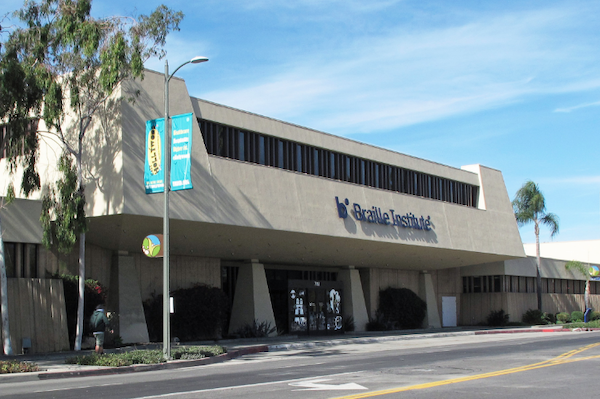
1. Braille Institute of America
1931 (current building built 1970)
741 N. Vermont Avenue, East Hollywood
In 1887, the same year Melrose Avenue was established, John Robert “Bob” Atkinson was born in Missouri, and in his 20s he found himself in Montana working as a cowboy until a gun accident in 1912 rendered him blind. Depressed and suicidal at his loss of vision, he had a literal “Come-To-Jesus” moment after listening to a hymn at a Christian Science church service and soon dedicated his life to giving visually-impaired people the ability to read and lead independent lives, starting with himself. In 1919 he founded the Universal Braille Press out of his East Hollywood garage, which was dedicated to translating books into the Braille format, beginning with a 1926 raised-dots version of the Bible, and expanded to translate other works, and amassed collections of other existing Braille publications. Universal Braille Press became the Braille Institute of America nonprofit and moved to a storefront on nearby Vermont Avenue in the 1930s where it continues today, offering free-of-charge living skills, technology, arts and music programs (its music program is funded by the foundation of songwriter and Capitol Records founder Johnny Mercer – more on him later) to visually-impaired individuals across Southern California.
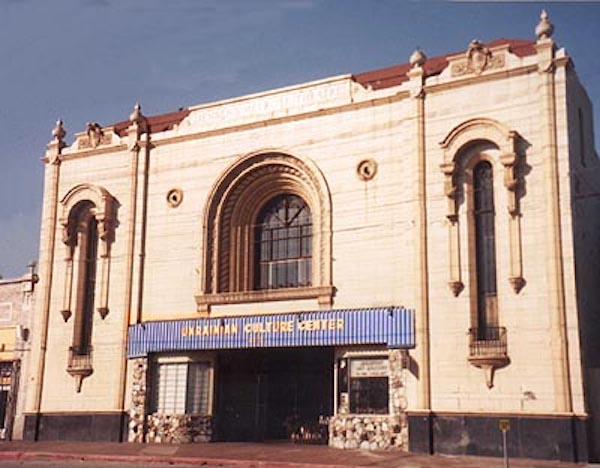
2. Ukrainian Culture Center/Jensen’s Melrose Theatre
1924
4315 Melrose Ave, East Hollywood
The Ukrainian Culture Center of Los Angeles opened in 1961 to serve what was then a strong ethnic enclave – a Ukrainian church stands just four blocks east. Today it is a popular venue for quinceañeras. The Grammy-winning indie rock band Arcade Fire played a “secret” show here in February 2011, prior to picking up their award that year. This building was built in 1924 (100 years ago!) as “Jensen’s Melrose Theatre” (one of a series of entertainment centers built by the Jensen brothers, whom also built one on Sunset Blvd in Echo Park), built for what was then an upper-class neighborhood located next to what was then UCLA (University of California, Southern Extension, now the Los Angeles City College campus). It was one of the last silent movie theatres built in the country, and operated until 1959. Take a look at the top of the facade — the original name of the building is etched in concrete! It’s been there for a century!
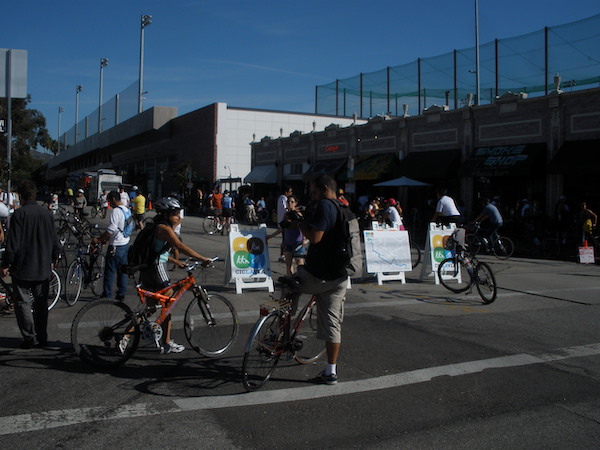
3. Hel-Mel/(Historic) Bicycle District
2000s Decade
Melrose Avenue and Heliotrope Drive, East Hollywood
A century ago, when what is now Los Angeles City College was the home of the O.G. UCLA campus, this area was basically the O.G. Westwood of its day, home to shops, restaurants and entertainment (the aforementioned Jensen’s Melrose Theatre) catering to students and faculty. In the 1980s, when the western end of Melrose was more new wave and rock, the eastern end was more punk and hip-hop, with the legendary punk/alt-rock institution The Anti-Club just a few blocks west (more on this later), and the intersection being home to DMC (Dance Music Centre), a record store selling 12″ singles (that’s “vinyls,” kids) catering to dance and rap music DJs. In fact, this iconic scene from the 1984 classic Breakin’ was filmed at Melrose and Heliotrope. In the early 2000s, the corner got a renaissance as the home of boutique stores and the Night in Tunisia Cafe, whose late-night hours and outdoor seating invited an unprecedented streetlife dynamic to the corner. In 2005, the nonprofit bicycle repair educational collective The Bicycle Kitchen was established at one of the storefronts on Heliotrope, and the legendary Scoops Ice Cream shop opened a couple doors down. Noticing the bike-centric scene, a local community organizer who lived up the street and one of the Bicycle Kitchen staff both came up with the “Hel-Mel” name while hanging out at the cafe one evening and it stuck. The fixie-specializing Orange 20 Bikes store and vegan Pure Luck Restaurant later opened across the street, adding to the synergy that made this a nightly hangout spot and de facto heart of the Los Angeles bike scene, which included the individuals who had the crazy idea to have a version of Bogota, Colombia’s weekly Sunday Ciclovia events here in the City of Angels. In October 2010 and April 2011, the first CicLAvias took place in a route that stretched seven miles from this very corner to Hollenbeck Park in Boyle Heights via Downtown. Today, The Bicycle Kitchen moved over a mile northeast, Scoops moved to Highland Park, the cafe changed hands over half a dozen times (and no longer stays open late), and Orange 20 and Pure Luck are no more, but there are over a dozen City-installed horseshoe bike racks in and around this intersection, and that crazy idea birthed by people in the bike community is still going strong, 50 events later. You know, it’s funny to think about something that happened when The Militant started blogging as “history”, but here we are.
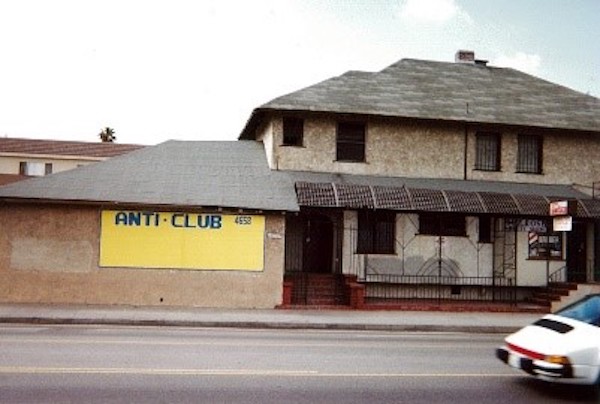
4. Site of The Anti-Club/Helen’s Place
1980
4658 Melrose Ave, East Hollywood
Founded by promoters Russell Jessum, the late Jack Marquette and the late Jim Van Tyne, The Anti-Club was an influential venue in Los Angeles’ punk and alternative scenes during the 1980s and 1990s. While venues in Hollywood, Chinatown and the Westside garnered more attention, this off-the-beaten path spot was more underground than underground, but also providing an early proving ground for acts like The Bangles, The Cult, Sonic Youth, the Red Hot Chili Peppers (more on them later…), The Minutemen, Circle Jerks, fIREHOSE and System of a Down. They all played here…which is an apartment building, which used to be a mini-mall (2011-2019). But it was a club venue before that. While hardcore Anti-Clubbers will point out the complicated relationship between the three promoters and venue owner Helen Guttman (having to do with who owned the rights to the name “Anti-Club”), The Militant will save that for another time.
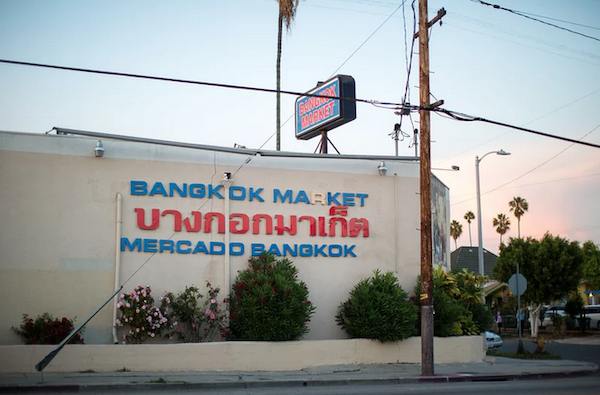
5. Historic Thai Town
1971
4700-4800 Block of Melrose Avenue, East Hollywood
You may be familiar with Thai Town, the half-mile stretch of Hollywood Boulevard known for its Thai New Year festival, pad thai, boat noodles, tom yum and notorious crispy pork gang activity. But that didn’t actually start until the 1990s. See, the O.G. Thai Town actually began on Melrose Avenue. In 1971, the Tilakamonkul family, who arrived from Thailand in the 1960s, opened Bangkok Market on 4800 Melrose Avenue. It was not only the first Thai food market in Los Angeles, but the first Thai market in the entire United States. Having access to authentic imported Thai food ingredients meant that one could open a Thai restaurant, and inevitably a handful soon opened in and around Melrose Avenue, and with that, Thai cuisine arrived in the USA. The Militant’s first exposure to Thai food was in the early 1980s at a restaurant near Vermont and Melrose (Gary’s Thongsai – it was awesome) and another at 4855 Melrose (Forgot the name, but the ruins are still there – it was in a converted house with a former miniature golf course out front and they served this real weird Thai/Nouvelle Cuisine fusion – really bad – there was this one desert that literally tasted like a candle). Most of the original Melrose Thai restaurants are gone, with the exception of Khun Dom (endorsed by the late, great Jonathan Gold himself) on 4861 Melrose. And as for the Tilakomonkul family, they moved their market across the street in 1986 where it operated until 2019, and their native Angeleno son Jet made quite a name for himself in the Celebrity Chef scene.
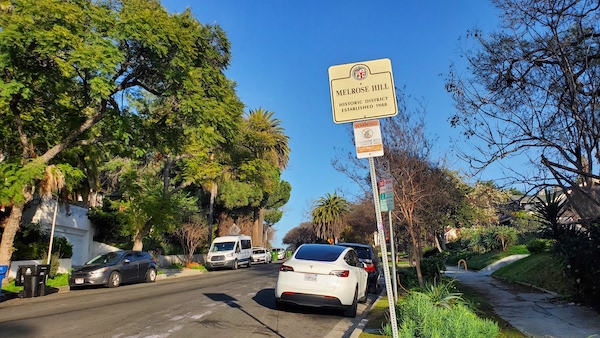
6. Melrose Hill
1911
Marathon Street & Melrose Hill, Melrose Hill
Take a quick detour from the CicLAvia route with a right at Hobart Blvd and a quick left at Marathon Street and you’ll find this secluded, tree-lined neighborhood that one of The Militant’s operatives who lives nearby describes as, “Straight Outta Mayberry.” Part of James McCarthy’s 1887 Melrose Tract, he named its highest point – at 337′ above sea level – “Melrose Hill.” In 1906 this area was purchased and subdivided by real estate investors Sidney Briggs and M.P. Gilbert, who sold lots starting at $425. Between 1911 and 1926, 42 Craftsman and Colonial Revival 1- and 2-story homes were built there. The fancy street lamps, forged from the same mold used for NYC’s Central Park lighting fixtures, were installed in 1980. The neighborhood became a Historic Preservation Overlay Zone in 1988. MH includes one of the most peculiar streets in Los Angeles – the eponymous Melrose Hill (not Melrose Hill Street or Melrose Hill Drive – just Melrose Hill), which, aside from its unique nomenclature (and killer views of Hollywood below), is a rare double cul-de-sac.
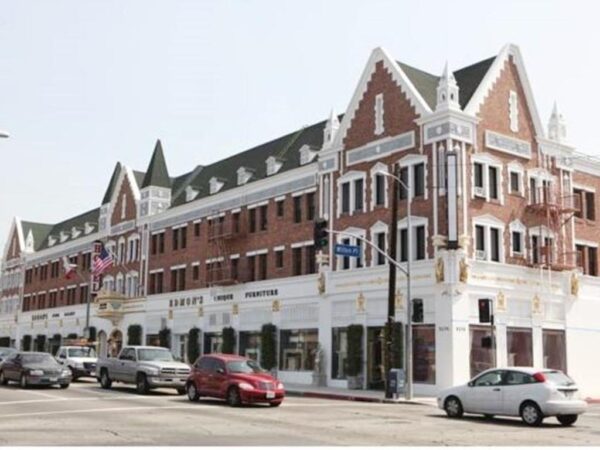
7. Hollywood Melrose Hotel
1927
5162 Melrose Ave, Hollywood
This three-story Norman Revival building was designed by S. Charles Lee (the architect who designed some 250 theaters in Southern California) and opened in 1927 as the Hollywood Melrose Hotel. It later became rental units known as the Melrose Arms and Monte Cristo Island Apartments. In 1992 it made the National Register of Historic Places and was returned to an inn in 2010, re-branded as the Hollywood Historic Hotel which is now run by the Armenian family that owns the Edmon’s Unique Furniture and Stone Gallery business on the ground floor.
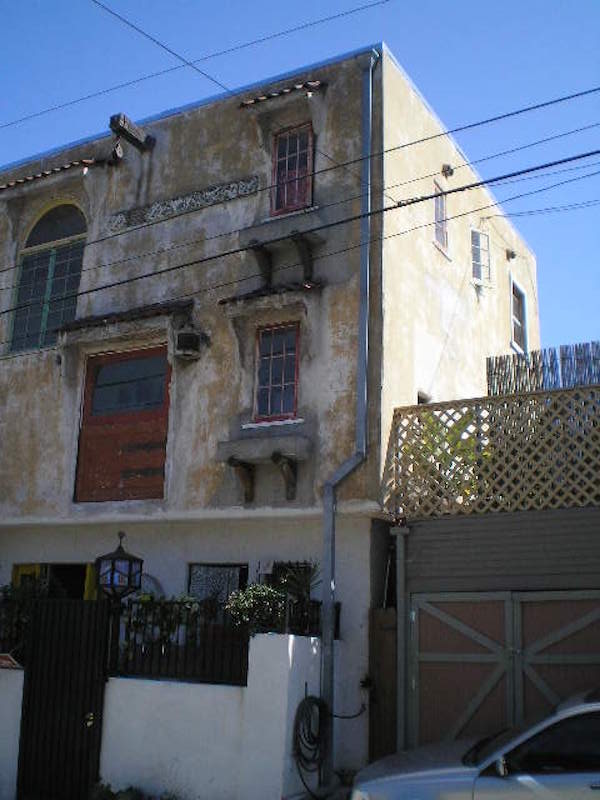
8. Jack London House
1923
5152 La Vista Ct, Hollywood
This may or may not be the former residence of famous writer Jack London, who has a bas-relief memorial sculpture on the outside wall of this unique, quirky 3-story residence in an alley named La Vista Court. Actually no, it was built seven years after London’s death, but it was designed by London’s friend, sculptor Finn Hakkon Frolich. This well-researched blog post details the history and mythology of the house that writer Jack London may or may not have lived in.
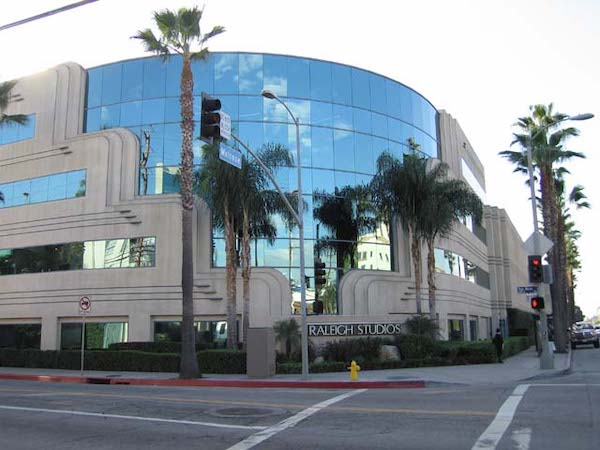
9. Raleigh Studios
1914
5300 Melrose Ave, Hollywood
Standing in the shadow of its much more famous neighbor across the street, this independent motion picture facility was founded in 1914 as the Fiction Players company studios, and later on as Clune Studios (Yes, the same William H. Clune that owned what later became Philharmonic Auditorium) in 1915. This studio facility was later associated with stars like Douglas Fairbanks and Charlie Chaplin. It was the filming location of classic TV shows like “The Adventures of Superman” and “Gunsmoke” (1950s); “Dallas,” and Madonna’s “Like A Prayer” music video (1980s) and Nirvana’s “Heart-Shaped Box” video (1990s).
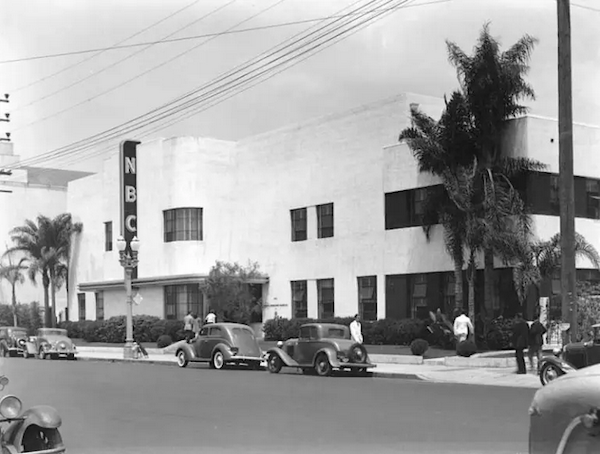
10. Historic NBC/Capitol Records/KHJ Radio/KCAL-TV Studios Building
1935
5515 Melrose Avenue, Hollywood
Much has been said about the more famous TV and motion picture studio just behind it, but this Streamline Moderne studio is one of the most storied buildings in Hollywood, playing a key part of its radio, television and music industry histories. Opened in December 1935 as the NBC radio network’s west coast headquarters, they soon moved to new digs at Hollywood and Vine (where today’s NBC Los Angeles TV affiliate was born) after quickly outgrowing the space. In 1940, the building was home to the old KFI radio and TV stations. In the late ’40s, when KFI moved to a new studio on Vine Street, this building was home to Decca Records, where in 1947, Bing Crosby’s holiday anthem, “White Christmas” was recorded. In 1949, Johnny Mercer (songwriter and Braille Institute supporter) bought the property as the first home of his new Capitol Records company, where it resided until it moved to its iconic tower on Vine in 1956. Speaking of Vine Street, the KFI TV & radio station – now called KHJ (Channel 9) – moved back to its old Melrose home from Vine. After being a rock & roll institution in the ’50s and ’60s known as “Boss Radio”, KHJ radio became KRTH (a.k.a. K-EARTH 101) in 1972 and re-lived its “Boss Radio” era as an Oldies Format station. In 1989, KHJ-TV was purchased by the Walt Disney Company and became KCAL-TV, which remained at the ultra-historic Melrose studio until 2002, when CBS purchased KCAL and moved it to Columbia Square on Sunset & Gower (and later to CBS Television City in 2007 where it remains today). The building is now part of the Paramount Studios lot, where it is the entry point to the Paramount Studio tour.
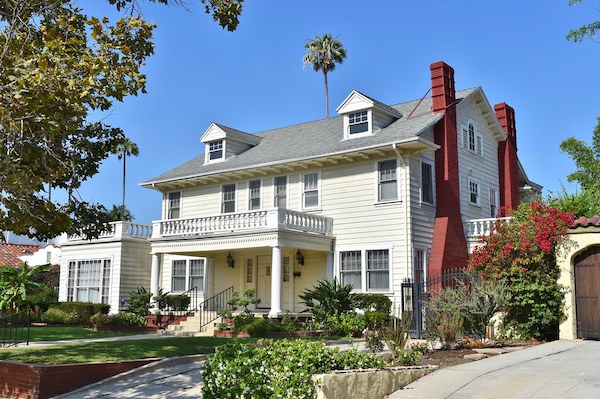
11. ‘Happy Days’ House
1923
565 N. Cahuenga Blvd, Hancock Park
“Aaaaaayyyyyyy!!!” Just south of the CicLAvia route is this familiar-looking Colonial-style house on 565 N. Cahuenga Blvd. It stood in for the Cunningham Residence in the hit ABC TV series, “Happy Days” from 1974 to 1984, where it was “565 Clinton Drive” in Milwaukee, Wisconsin (Interesting, since Clinton Street is the closest intersection). Though mostly used in establishing shots, the actual sitcom was filmed a half mile to the east at Paramount Studios.
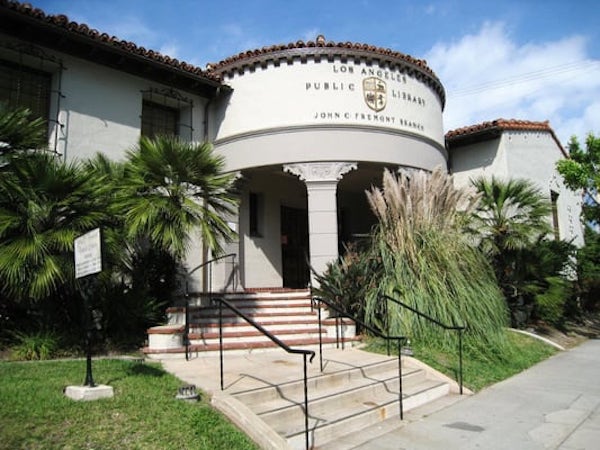
12. John C. Fremont Branch Library
1927
6121 Melrose Ave, Hollywood
Opened on June 1, 1927, this Merl L. Barker -designed Mediterranean Renaissance branch of the Los Angeles Public Library system opened to serve the Hollywood, Hancock Park and West Hollywood communities. In 1950 it was almost doomed to closure due to a City budget crisis at the time, but an infusion of city property tax revenue from the recently-completed Park La Brea complex nearby enabled it and other branch libraries to continue operating. Like a handful of LAPL branches damaged in the 1987 Whittier and 1994 Northridge earthquakes, the Fremont Branch was closed and temporarily relocated nearby in the early-mid 1990s. It is both a Los Angeles City Historic-Cultural Monument (#303) and on the U.S. National Register of Historic Places (#87001009). Look for it in the 3rd season of the Amazon series ‘Bosch: Legacy’!
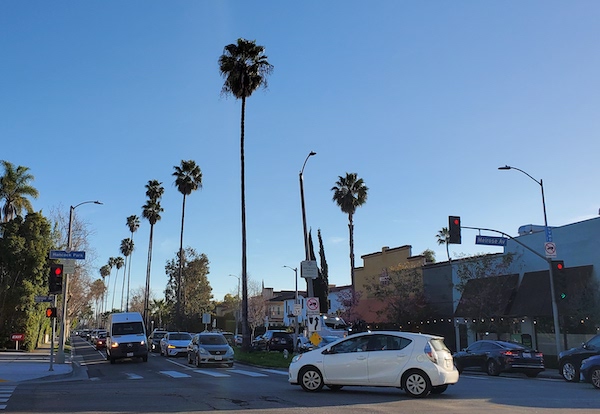
13. Highland Avenue Median
1928
Highland Avenue between Melrose Avenue and Wilshire Boulevard, Hancock Park
Street medians in Los Angeles are usually signs of the remnants of Pacific Electric or Los Angeles Railway streetcar rights-of-way, but this 1.5-mile strip of Highland never saw a single trolley roll on it (it did north of Santa Monica Boulevard, though), though it was on the PE’s wish list of possible expansion lines that never got built (like the winding median in the center of north Vermont Avenue above Los Feliz Boulevard towards Griffith Park). In 1928, the bougie residents of Highland Avenue pooled their money together (of which they had lots) and beautified their median with grass and Queen and Washingtonia Robusta palm trees. In 1972, the median became a Los Angeles Historic Cultural Monument (#94)
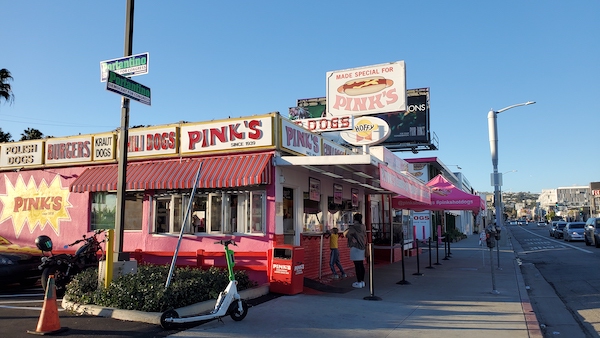
14. Pink’s Hot Dogs
1939 (Current building built 1946)
709 N. La Brea Avenue, Hollywood
The dream of turning a street food stand into a brick-and-mortar restaurant is not a new thing; Paul and Betty Pink did it years ago when Betty borrowed money from her mother to buy a hot dog cart and rent land for $15 a month towards the end of the Great Depression in 1939. They sold hot dogs for a dime and Cokes for 5 cents. After their landlord raised their rent, they got a $4,000 bank loan to purchase the land and in 1946 built a permanent structure which stands today. Known for its celebrity-named menu items named after its celebrity clientele and long-ass lines (Pro Tip: no lines on Tuesdays and Wednesdays!), Pink’s is a Los Angeles food institution from the pre-ethnic food era where simply adding chili on something made it uniquely Los Angeles. Today, you can find Pink’s at various locations around SoCal, as well as in Las Vegas, Pennsylvania, Connecticut and the Philippines. But the O.G. is right here.
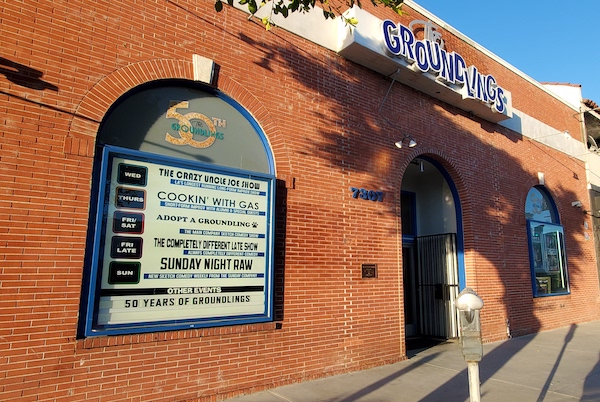
15. The Groundlings Theatre
1975
7307 Melrose Ave, Hollywood
With a name borrowed from a line in Shakespeare’s Hamlet (“…to split the ears of the groundlings, who for the most part are capable of nothing but inexplicable dumbshows and noise.”), referring to the lower-class people who were relegated to sitting on the ground to watch plays at London’s esteemed Globe Theatre, The Groundlings improv company and school was founded 50 years ago by the late improvisational theatre director Gary Austin after a stint as a stand-up comic at The Comedy Store and doing improv comedy workshops in the early 1970s. This Los Angeles improv institution became the launchpad for countless comedians, actors and entertainers, from [takes long breath] the late Paul (Pee-Wee Herman) Reubens, Cassandra (Elvira, Mistress of the Dark) Peterson, Lisa Kudrow, Conan O’Brien, Jimmy Fallon, Edie McClurg, Pat Morita, Phil LaMarr, Craig T. Nelson, and Saturday Night Live alums [takes even longer breath] Laraine Newman, the late Phil Hartman, Jon Lovitz, Jan Hooks, Will Ferrell, Maya Rudolph, Will Forte, Kristen Wiig, andmanymoreothersokaygonnaquitnowTheMilitantisrunningoutofbreath.
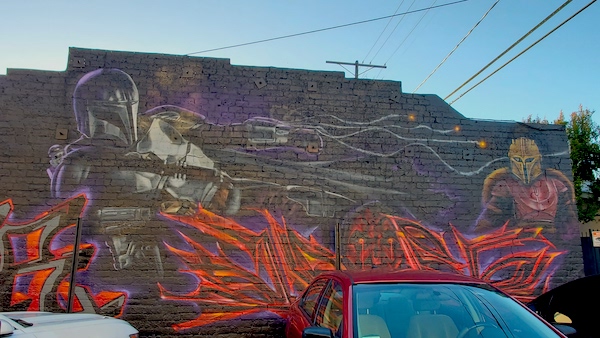
16. Street Murals of Melrose
Circa late 1980s
Various locations around Melrose Avenue, centered around Melrose & Fuller avenues, West Hollywood
Never mind that a certain abandoned skyscraper in Downtown Los Angeles’ South Park sector has stolen the spotlight as the hotspot of graffiti art lately. Melrose Avenue has had it since the late 1980s. Along the CicLAvia route west of La Brea, on side streets and in the unnamed parallel alleyways north and south of the avenue, you’ll see countless aerosol murals. Lots of them. And not just on walls, but on utility boxes as well. There are depictions of pop culture characters (Star Wars, The Simpsons), original characters from artists, and at least four murals of the late Lakers legend Kobe Bryant alone. But the most apt example of Melrose graffiti art is the artistic interpretation of the name “MELROSE” on the west-facing wall of the Foot Locker on 7720 Melrose (at Genessee Avenue).
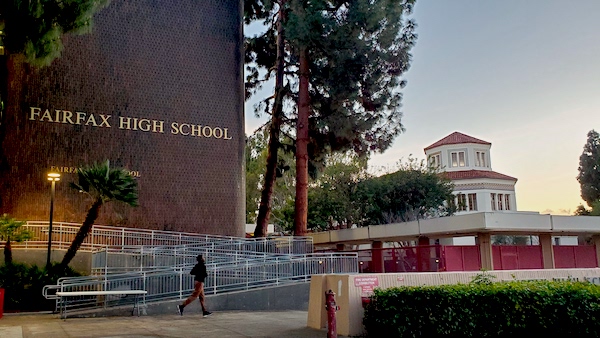
17. Fairfax High School
1924
7850 Melrose Ave, Hollywood
Opened in 1924 (that’s 100 years ago!) the 24-acre campus originally featured Spanish Colonial Revival structures, most of which were razed in the 1960s due to not adhering to earthquake codes. But the D.S. Swan school auditorium with its characteristic rotunda structure survived due to the efforts of historic preservationists. In an era where high school students actually had a say in school affairs (what a concept…), the Greenway Court building was built as somewhat of a social hall/student union structure in 1939. It was later moved from the middle of campus to its current Fairfax Avenue location, where it is no longer part of the LAUSD school campus but is now run as a performance venue by a theater company. NYC punk band The Ramones may have created the song, “Rock ‘n’ Roll High School,” but if there’s a real-life secondary school institution that specializes in Rock and/or Roll, it’s Fairfax High. Notable alumni includes founding members of the Red Hot Chili Peppers (Anthony Kiedis, Michael “Flea” Balzary, original drummer Jack Irons and the late guitarist Hillel Slovak) and Guns ‘N Roses (Saul “Slash” Hudson, Tracy “Tracii Guns” Ulrich, and original drummer Rob Gardner), as well as trumpeter and record executive Herb “The ‘A’ in ‘A&M Records'” Alpert, record exec Mo Ostin, producer and convicted murderer Phil Spector (who incidentally did produce The Ramones’ “Rock ‘n’ Roll High School”), musician Warren Zevon, songwriter Jerry Lieber (“Stand By Me,” “Yakkity-Yak”), Eleven lead singer/guitarist Alain Johannes, and The Honeys singer (and ex-wife of Brian Wilson and mother of 2/3 of Wilson Phillips) Marilyn Wilson-Rutherford. That’s more enough Rock Rock Rock, Rock ‘n’ Roll High School cred right there! Another Fairfax High notable: former principal Jim Tunney (1964-1970) later became a well-known NFL referee, officiating Super Bowls VI, XI and XII.
Also conveniently taking place during CicLAvia at the front parking lots of the Fairfax High campus is the weekly Melrose Trading Post which has provided an outdoor flea/craft/food market ($6 admission for people 13 and above – which also financially supports the school) since 1997. It runs until 5 p.m., so it’s the perfect place to hang after the Po-Po Party Pooper Patrol rolls by!
BONUS: THE OFFICIAL MILITANT ANGELENO EPIC CICLAVIA TOUR FOOD GUIDE!
Rincon Chileno
4354 Melrose Ave, East Hollywood
Open Sun, Tue & Wed, 11 a.m.-6 p.m.; Thu & Fri, 11 a.m.-7 p.m.; Sat, 11 a.m.-8 p.m.; Closed Mon
A great spot for Chilean fare in this very diverse food neighborhood (where you can get Mexican, Korean, Japanese, Filipino, Thai, Vietnamese, El Salvadoran, Armenian, Indian and Guatemalan food within a one-mile radius of here), but what you really want are the Chilean empanadas served in the deli/market section next door to the sit-down restaurant. For $3.75 each you get a HUGE Chilean-style empanada (oven-warmed at your request) in beef, chicken or cheese versions. Probably one of the best under-$5 meal deals you’ll find in the neighborhood.
Khun Dom
4681 Melrose Ave, East Hollywood
Open Mon-Sun, 10 a.m. – 9 p.m.
There are a handful of Thai Restaurants on Melrose, but Khun Dom is the last of the O.G. Thai restaurants from the ’70s and ’80s along Melrose. The menu is standard (Bankgok urban) Thai cuisine you’d find in 90% of Thai establishments, but this old school Historic Thai Town institution is praised by locals and the late Jonathan Gold, so there you go.
Maison Matho
4770 Melrose Ave, East Hollywood
Open Mon, Tue & Thu 7 a.m.-2 p.m.; Fri 7 a.m.-4 p.m.; Sat & Sun 8 a.m.-4 p.m.; Closed Wed
This little French-style café stand (translated as “Matho House”), open since April 2021, brings a little Paris flavor to Hollywood-Est. Specializing in coffee, pastries, sandwiches (understand that French sandwiches use butter and not mayo as a common condiment, and the bread is supposed to be really good) and salads. As they’re not open past 4 p.m., this is more of a breakfast/lunch place. The place is set up for takeout or delivery, but there’s a small outdoor eating area where one can chill like they’re on the Champs-Elysees.
Le Coupe
709 N. Western Ave, East Hollywood
Open Wed-Sun, 12 p.m.-8 p.m.
There are numerous fried hot chicken sandwich places around town (including the first brick-and-mortar Dave’s Hot Chicken, just half a mile up Western), but this place is supposed to be one of The Elite hot chicken sandwich places in Los Angeles. The Militant hasn’t eaten here yet, but he’s heard lots of great things about it (like its ginormous fried chicken patty), and will likely spend his food cash here on Sunday.
Mi Ranchito Veracruz
5200 Melrose Ave, Hollywood
Open Sun & Mon, 9 a.m.-4 p.m.; Tue-Sat, 9 a.m.-8 p.m.
One of the best Mexican joints on Melrose serves up Oaxacan and Veracruz-style cuisine, specializing in chilaquiles, burritos (especially breakfast burritos), tamales and empanadas. The Militant has eaten here once and it’s pretty dang good.
Astro Burger
5601 Melrose Ave, Hollywood
Open Sun 9 a.m.-10 p.m.; Mon-Sat 7 a.m.-10 p.m.
Doyer fans, don’t let the name trigger you. This place has been around for 50 years and is the quintessential Melrose burger joint (and take-out lunch spot for many a Paramount employee). Classic SoCal-style drive-thru burgers with thick steak-type fries are the specialty here, but they also serve breakfast diner fare, Greek cuisine and vegetarian dishes.
Mario’s Peruvian & Seafood
5786 Melrose Ave, Hollywood
Open Sun & Mon-Fri, 11:30 a.m.-8 p.m.; Fri & Sat, 11:30 a.m.-9:30 p.m.
You’ve probably seen lots of “Mario’s Peruvian” restaurants around Southern California, but this is the O.G. location right here. Started by Mario Tamashiro, a Peruvian chef of Japanese heritage, this place has a solid clientele that comes for the Lomo Saltado, Pollo Saltado and Saltado de Mariscos. This is the place, but you might have to wait for a table.
Pink’s Hot Dogs
709 N. La Brea, Hollywood
Open Sun-Thu, 9:30 a.m.-12 a.m.; Fri & Sat 9:30 a.m.-2 a.m.
Needs no introduction.
Snakepit Alehouse Whiskey Bar & Kitchen
7529 Melrose Ave, Hollywood
Open Sun & Mon-Thu, 3 p.m.-12 a.m.; Fri & Sat, 3 p.m.-2 a.m.
The Militant stumbled upon this place on Melrose and Sierra Bonita during his pre-CicLAvia scope-out of the route (he walked the entire route round-trip in two visits) and this very non-pretentious neighborhood bar caught his eye. Though he can’t vouch for the food, it looks like decent pub grub, but the real appeal of the place is its craft beer and whiskey selection. It opens at 3 p.m., which is when CicLAvia ends, making it the perfect post-CicLAvia hangout. Just make sure you’re able to find safe alternate bike routes home or to the nearest transit station/stop afterward.
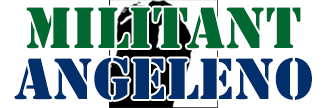
“In the late ’40s, when KFI moved to a new studio on Vine Street, this building was home to Decca Records, where in 1947, Bing Crosby’s holiday anthem, “White Christmas” was recorded.” — this is almost certainly not the case. For starters, the Decca Studio was next door at _5505_ Melrose (easy to see how the mistake came to be;this has now been torn down and is a Paramount hedge) and that’s where many people say “White Christmas” was recorded. The other studio that where it claimed to have been recorded is Radio Recorders. BUT–both could be true, because there were two versions of White Christmas, the original in 1942 and the remake in 1947 (because the original master disk had gotten too worn out–1942 was before tape!). If a version was recorded at Radio Recorders, it was not at the studio at Santa Monica and Orange that has the plaque about Radio Recorders–they moved there in 1949. Before that they would have been at 932 N. Western Avenue, just up from this CicLAvia route. 🙂 Most of this stuff is easily Googleable, but let me know if you need sources. Thanks for doing these!